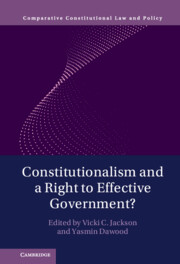Book contents
- Constitutionalism and a Right to Effective Government?
- Comparative Constitutional Law and Policy
- Constitutionalism and a Right to Effective Government?
- Copyright page
- Dedication
- Contents
- Tables
- Contributors
- Acknowledgments
- Part I Introduction
- 1 Constitutionalism and Effective Government
- Part II What Are Constitutions For?
- Part III Positive Rights and Rights to Effective Self-Government
- Part IV The Role of Courts in Building State Capacity and Promoting Effective Self-Government While Protecting Rights
- Part V Executive and Administrative Constitutionalism in Effective Democratic Government
- Part VI Legislatures, Representation, and Duties of Effective Self-Government
- Part VII Politics, Sociology, Media, and Corruption as Contexts for Constitutionalism and Governance
- Index
1 - Constitutionalism and Effective Government
Rights, Institutions, and Values
from Part I - Introduction
Published online by Cambridge University Press: 20 October 2022
- Constitutionalism and a Right to Effective Government?
- Comparative Constitutional Law and Policy
- Constitutionalism and a Right to Effective Government?
- Copyright page
- Dedication
- Contents
- Tables
- Contributors
- Acknowledgments
- Part I Introduction
- 1 Constitutionalism and Effective Government
- Part II What Are Constitutions For?
- Part III Positive Rights and Rights to Effective Self-Government
- Part IV The Role of Courts in Building State Capacity and Promoting Effective Self-Government While Protecting Rights
- Part V Executive and Administrative Constitutionalism in Effective Democratic Government
- Part VI Legislatures, Representation, and Duties of Effective Self-Government
- Part VII Politics, Sociology, Media, and Corruption as Contexts for Constitutionalism and Governance
- Index
Summary
In recent years, nations around the world have faced a veritable crisis of ineffective government. Basic governmental functions – preventing private violence, resolving disputes through lawful means, providing an infrastructure to enable people to meet their most elementary needs for shelter, nutrition, transportation, communication, education – go unmet. In some countries, these basic functions are met but longer-term governance issues languish, and government is perceived to be unresponsive in ways that some believe contribute to political backlashes, including those against minority groups. These failures in governance are also perceived to have contributed to a global upsurge in authoritarianism and a concomitant decline in democracy.1
Moreover, the basic freedoms protected in many democratic constitutions – freedom from state-sanctioned torture and from punishment or coercion without fair process; freedom of expression, of religion, of movement; freedom from invidious discrimination; enjoyment of property without arbitrary government interference; free exercise of the suffrage – cannot exist, in an organized society, without government effective enough to control itself and its agents and otherwise to secure the protection of those rights.
Keywords
- Type
- Chapter
- Information
- Publisher: Cambridge University PressPrint publication year: 2022

